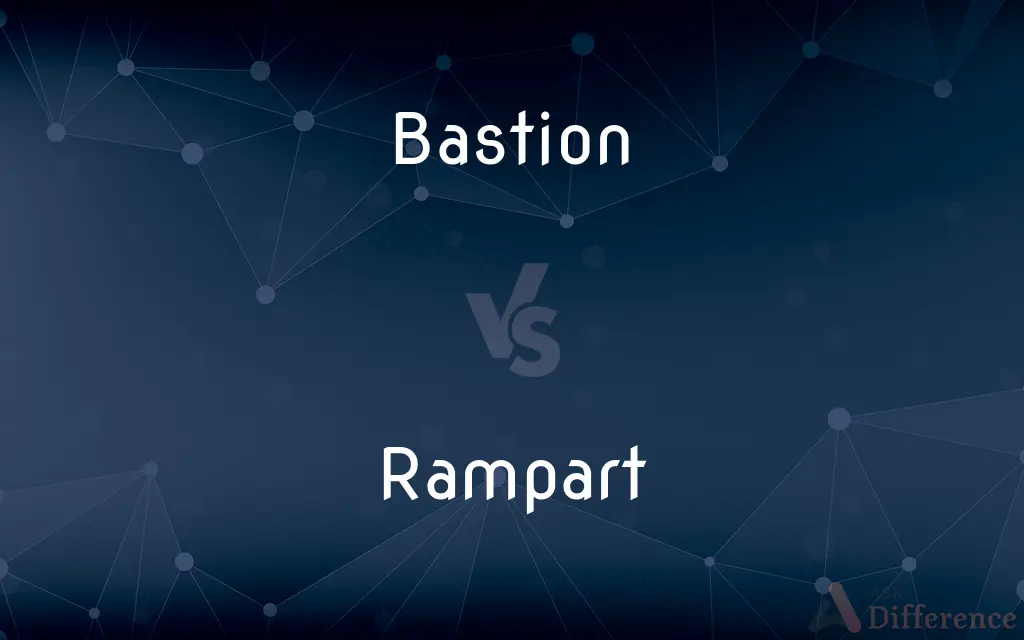Bastion vs. Rampart — What's the Difference?
Edited by Tayyaba Rehman — By Maham Liaqat — Updated on May 8, 2024
A bastion is a projecting part of a fortification, designed for defensive artillery; a rampart is a broad, defensive wall surrounding a fort or castle.

Difference Between Bastion and Rampart
Table of Contents
ADVERTISEMENT
Key Differences
A bastion extends outward from the main walls of a fortress, allowing defenders to fire along the approaching paths to the fort, thus increasing the fortification's field of fire. On the other hand, a rampart is a defensive wall that is often built to enclose a space, providing a first line of defense against attacks.
Bastions are typically angular in shape and structured to provide crossfire coverage in multiple directions, enhancing the defensive strategy of a fortification. In contrast, ramparts are usually straight and form the main protective barrier, often accompanied by a walkway on top for guards.
The design of bastions, especially during the Renaissance, was crucial in the development of star forts, which used bastions at each corner to create a perimeter hard to breach. Whereas ramparts have been used since ancient times and are simpler in design, focusing on height and thickness to resist assault.
While bastions are integral parts of fortifications specifically designed for artillery placements, ramparts primarily serve as protective barriers that can also act as fighting platforms for defending troops.
Bastions and ramparts often work together in historic fortification architecture, with bastions providing advanced defense points protruding from the main ramparts, enhancing the overall defensive capability of a fortress.
ADVERTISEMENT
Comparison Chart
Definition
Projecting part of fortification for defense
Broad defensive wall around a fort
Shape
Angular, designed for crossfire
Usually straight, high and thick
Historical Usage
Integral in star forts for artillery defense
Used since ancient times for basic defense
Function
Artillery placement and strategic defense
Main protective barrier and fighting platform
Architectural Relationship
Protrudes from ramparts or walls
Encloses or forms the main defensive perimeter
Compare with Definitions
Bastion
Artillery position.
Cannons were mounted on the bastion for better defense.
Rampart
Historical fortification.
The ancient rampart has stood against many sieges over the centuries.
Bastion
Architectural element.
The bastion's design was critical for the fort's overall defense strategy.
Rampart
Protective barrier.
Soldiers patrolled the rampart day and night.
Bastion
Projecting defense.
Each bastion at the fort provided an excellent view for targeting approaching enemies.
Rampart
Elevated path.
The top of the rampart served as a lookout point.
Bastion
Fortification feature.
The old fortress has five bastions, each capable of sweeping the fields before it.
Rampart
Defensive wall.
The castle's rampart was over ten feet thick.
Bastion
Military stronghold.
The bastion was crucial in defending the city from invaders.
Rampart
Enclosing structure.
The rampart encircled the entire medieval town.
Bastion
A bastion or bulwark is a structure projecting outward from the curtain wall of a fortification, most commonly angular in shape and positioned at the corners of the fort. The fully developed bastion consists of two faces and two flanks, with fire from the flanks being able to protect the curtain wall and the adjacent bastions.
Rampart
A fortification consisting of an embankment, often with a parapet built on top.
Bastion
A projecting part of a fortification.
Rampart
A means of protection or defense; a bulwark.
Bastion
A well-fortified position.
Rampart
To fortify or surround with a rampart.
Bastion
One that upholds or defends something, as against neglect or unpopularity
A college that is a bastion of traditionalism.
Rampart
A defensive mound of earth or a wall with a broad top and usually a stone parapet; a wall-like ridge of earth, stones or debris; an embankment for defensive purpose.
Bastion
(architecture) A projecting part of a rampart or other fortification.
Rampart
A defensive structure; a protective barrier; a bulwark.
Bastion
A well-fortified position; a stronghold or citadel.
Rampart
That which defends against intrusion from outside; a protection.
Bastion
(figuratively) A person, group, or thing, that strongly defends some principle.
A bastion of hope
The bastion of democracy
Rampart
A steep bank of a river or gorge.
Bastion
Any large prominence; something that resembles a bastion in size and form.
Rampart
To defend with a rampart; fortify or surround with a rampart.
Bastion
(transitive) To furnish with a bastion.
Rampart
That which fortifies and defends from assault; that which secures safety; a defense or bulwark.
Bastion
A work projecting outward from the main inclosure of a fortification, consisting of two faces and two flanks, and so constructed that it is able to defend by a flanking fire the adjacent curtain, or wall which extends from one bastion to another. Two adjacent bastions are connected by the curtain, which joins the flank of one with the adjacent flank of the other. The distance between the flanks of a bastion is called the gorge. A lunette is a detached bastion. See Ravelin.
Rampart
A broad embankment of earth round a place, upon which the parapet is raised. It forms the substratum of every permanent fortification.
Bastion
A group that defends a principle;
A bastion against corruption
The last bastion of communism
Rampart
To surround or protect with, or as with, a rampart or ramparts.
Those grassy hills, those glittering dells,Proudly ramparted with rocks.
Bastion
A stronghold into which people could go for shelter during a battle
Rampart
An embankment built around a space for defensive purposes;
They stormed the ramparts of the city
They blew the trumpet and the walls came tumbling down
Bastion
Projecting part of a rampart or other fortification
Common Curiosities
How does a rampart contribute to a fortress's defense?
A rampart acts as a primary defensive barrier, often tall and thick to withstand attacks and provide a platform for defenders.
Can bastions and ramparts be found in modern architecture?
While less common in modern architecture, bastions and ramparts are often features in historical preservation sites and military-themed constructions.
How do bastions differ from watchtowers?
Bastions are designed for wide area defense and artillery placement, while watchtowers are primarily for observation and signaling.
What is the typical height of a rampart?
The height of ramparts can vary, but they are typically high enough to provide substantial protection and allow defenders to oversee the surrounding area.
What is the main purpose of a bastion in a fort?
A bastion is designed to extend the field of fire and provide strategic defense points within a fortification.
What era saw the peak use of bastions and ramparts?
The peak use of bastions was during the Renaissance with the development of star forts, while ramparts have been used since ancient times.
Are there any famous forts that feature both bastions and ramparts?
Many European star forts and medieval castles feature both bastions and ramparts, such as those seen in cities like Nicosia, Cyprus, and Palmanova, Italy.
How do bastions enhance the effectiveness of ramparts?
Bastions enhance ramparts by providing outward-projecting defense points that allow defenders to cover more area and create crossfire zones.
What materials are used to build bastions and ramparts?
Traditionally, both bastions and ramparts were constructed from materials like stone, brick, or earth, depending on the era and location.
How has the role of bastions and ramparts changed in modern military strategy?
In modern military strategy, the roles of bastions and ramparts have diminished due to advances in warfare technology, though they remain important in historical and ceremonial contexts.
Share Your Discovery

Previous Comparison
Reservations vs. Booking
Next Comparison
Communicating vs. TalkingAuthor Spotlight
Written by
Maham LiaqatEdited by
Tayyaba RehmanTayyaba Rehman is a distinguished writer, currently serving as a primary contributor to askdifference.com. As a researcher in semantics and etymology, Tayyaba's passion for the complexity of languages and their distinctions has found a perfect home on the platform. Tayyaba delves into the intricacies of language, distinguishing between commonly confused words and phrases, thereby providing clarity for readers worldwide.
















































